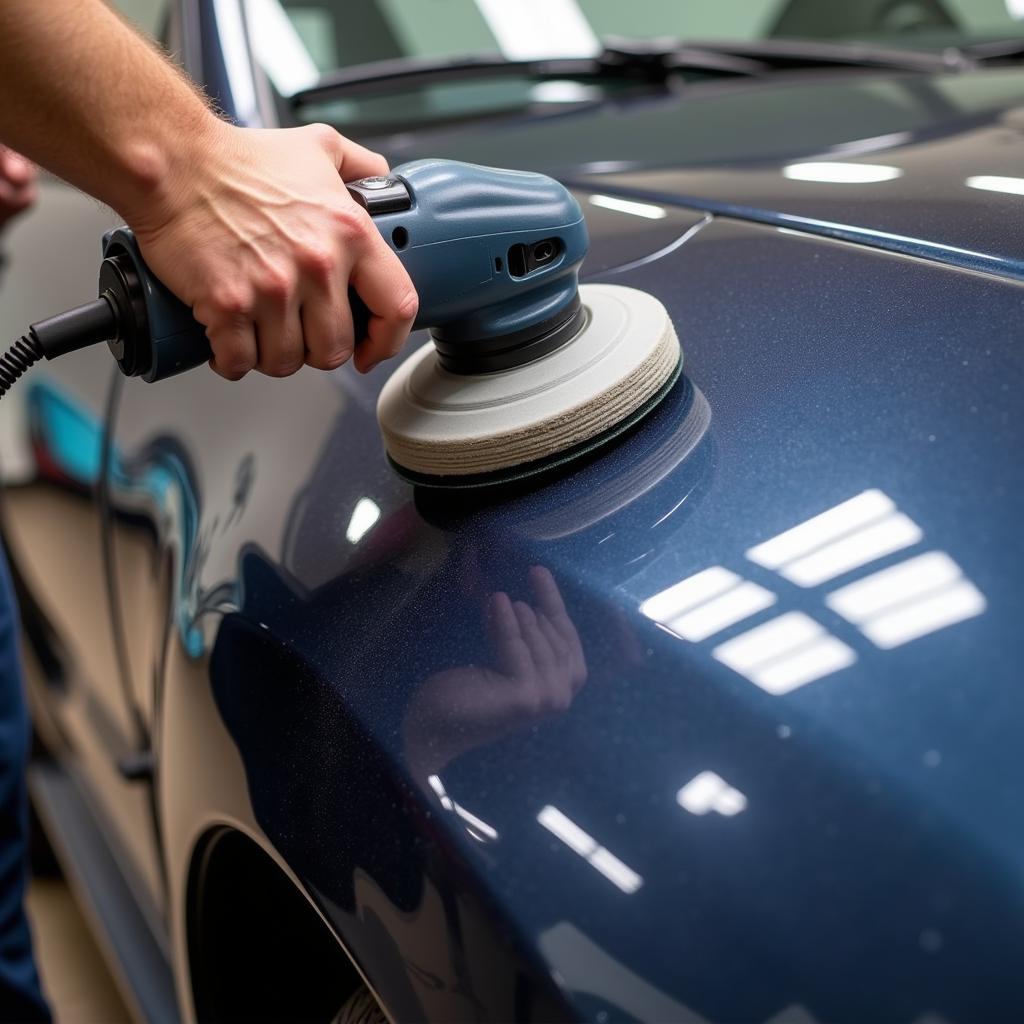Choosing the right polisher is crucial for achieving a flawless finish in car detailing. Electric vs. air power polishers is a common debate, with each type boasting unique advantages and disadvantages. This guide will provide an in-depth comparison to help you make the best decision for your car detailing needs.
Understanding the Basics: Electric vs. Air Polishers
Electric polishers are powered by electricity and offer varying levels of power and control. Air polishers, on the other hand, rely on compressed air supplied by an air compressor. This fundamental difference impacts their performance characteristics, making them suitable for distinct applications in car detailing.
Electric Polishers: Power and Control at Your Fingertips
Electric polishers are generally categorized into rotary and dual-action (DA) types. Rotary polishers offer high cutting power for removing severe defects like deep scratches and swirls, but require expertise to avoid paint damage. DA polishers, with their oscillating and rotating motion, are more forgiving and safer for beginners, ideal for correcting light to moderate imperfections and enhancing gloss.
Advantages of Electric Polishers:
- Ease of Use: No need for an air compressor, simply plug and play.
- Portability: Easier to transport and use in various locations.
- Consistent Power: Delivers consistent speed and power regardless of air pressure fluctuations.
- Variety of Options: Wide range of brands, models, and pad sizes available to suit different needs and budgets.
Disadvantages of Electric Polishers:
- Cord Management: Can be cumbersome to manage the power cord.
- Weight: Some models can be heavy, leading to fatigue during extended use.
- Heat Buildup: Can generate heat, requiring careful monitoring to prevent paint damage.
Air Polishers: The Professional’s Choice
Air polishers are favored by many professional detailers for their high speed, low vibration, and precise control. They excel at producing a swirl-free, high-gloss finish.
Advantages of Air Polishers:
- Lightweight: Reduces hand fatigue during prolonged detailing sessions.
- Low Vibration: Minimizes vibrations, providing greater control and reducing the risk of swirl marks.
- High Speed: Achieves high RPMs, ideal for achieving a flawless finish.
- Cooler Operation: Generates less heat than electric polishers, reducing the risk of paint damage.
Disadvantages of Air Polishers:
- Requires Air Compressor: Adds to the overall cost and requires space for storage and operation.
- Air Hose Management: Can be restrictive and require careful maneuvering.
- Noise Level: Generally louder than electric polishers.
Which Polisher is Right for You?
Choosing the right polisher depends on your skill level, detailing goals, and budget.
- Beginners: A DA electric polisher is an excellent starting point, offering a balance of safety, ease of use, and corrective ability.
- Enthusiasts: A powerful DA electric polisher or an entry-level air polisher provides more options for tackling various paint correction tasks.
- Professionals: Air polishers are often preferred for their precision and ability to achieve a flawless, high-gloss finish.
 Car Detailing with Dual Action Polisher
Car Detailing with Dual Action Polisher
“For beginners, I always recommend starting with a dual-action electric polisher,” says renowned detailing expert, Michael Davies. “They’re forgiving and allow you to develop your skills without the risk of damaging the paint.”
Choosing the Right Pads and Compounds
Regardless of the polisher type, choosing the right pads and compounds is essential. Different pads and compounds are designed for specific levels of correction and finishing. Experimentation and practice are key to mastering the art of paint correction.
“Matching the pad and compound is crucial for achieving the desired results,” adds Davies. “A more aggressive pad and compound combination is needed for removing deeper imperfections, while a finer pad and compound are used for polishing and refining the finish.”
Conclusion: Making the Informed Decision
Choosing between an electric and air power polisher for car detailing depends on your specific needs and preferences. Electric polishers offer convenience and versatility, while air polishers excel in precision and control. By understanding the strengths and weaknesses of each type, you can make an informed decision and achieve professional-grade results in your car detailing endeavors.
FAQs
- What is the difference between a rotary and a dual-action polisher?
- Which type of polisher is best for removing swirl marks?
- What are the benefits of using an air polisher?
- What safety precautions should I take when using a car polisher?
- How do I choose the right polishing pad and compound?
- What is the average cost of an electric vs. an air polisher?
- How do I maintain my car polisher?
Common Car Detailing Scenarios and Polisher Choices
- Scenario 1: Removing light scratches and swirl marks on a daily driver – Dual-Action Electric Polisher
- Scenario 2: Correcting heavy paint defects on a show car – Rotary Electric Polisher or Air Polisher
- Scenario 3: Polishing and refining the paint on a classic car – Air Polisher
- Scenario 4: Enhancing the gloss on a newly painted car – Dual-Action Electric Polisher
Explore More Car Detailing Tips
- Check out our article on “Choosing the Right Car Wax for Your Paint Type”
- Learn more about “Interior Car Detailing: A Step-by-Step Guide”
For any assistance, please contact us via WhatsApp: +1(641)206-8880, Email: [email protected]. Our customer service team is available 24/7.

Leave a Reply